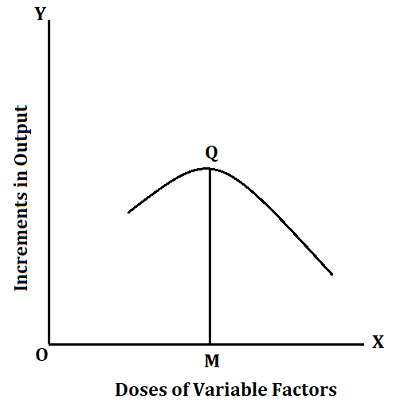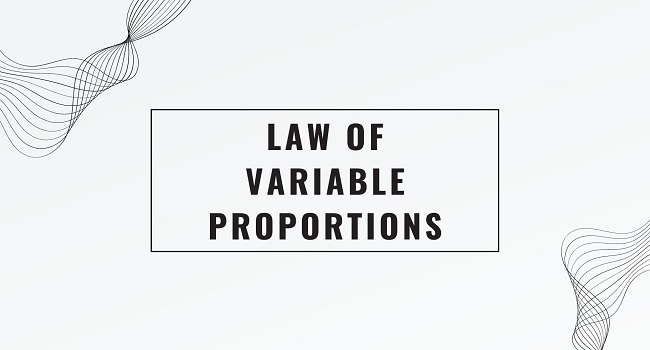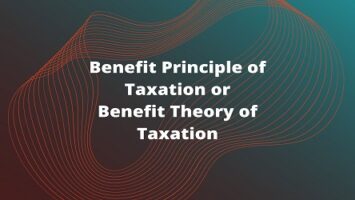Table of Contents
Law of Variable Proportions:
The law of variable proportions is a very old economic law. Physiocrats, it is said, were the first to discover the working of the laws of returns and associated the law of increasing returns with agriculture. Classical economists like Adam Smith, David Ricardo, and Malthus, on the contrary, associated the law of diminishing returns with agriculture. They gave concentrated attention to the law of variable proportions on the basis of which they built several other economic laws like the Ricardina theory of rent and the Malthusian theory of population. For classical economists, the law of variable proportions was the basic economic law that provided the foundation for several other economic generalizations. But they rigidly confined the working of the law to agriculture alone. Dr. Marshall, though he improved upon the classical formulation of the law, continued to confine the operation of the law, like the classicists, to agriculture alone. This would be obvious from Marshall’s statement of the law which runs as follows:
“An increase in the capital and labor applied in the cultivation of land causes in general a less than proportionate increase in the amount of produce raised, unless it happens to coincide with an improvement in the arts of agriculture.”
Marshall’s approach to the law thus bears similarity to the classical approach rather than to the modern approach to the law. The modern approach to the law is altogether different. According to modern economists, the law works not only in agriculture but also in other fields of economic activity including manufacturing industries. The law will operate in all those fields of activity where one or two factors of production are fixed while the others are variable. It is, therefore, not correct to say that the law of variable proportions works only in agriculture.
The Law of Variable Proportions may be stated as follows: “If we keep the quantity of one or more factors of production constant and gradually increase the quantities of the other variable factors (used with the fixed factors), then after a point, the corresponding return to every additional unit of the variable factors will begin to diminish. In other words, the additional quantities of the variable factors will, after a point, yield diminishing returns.”
There is nothing in their definition that suggests that the law of variable proportions applies to agriculture only.
Let us suppose that there are three factors of production A, B, and C. A is kept constant while the quantities of B and C are gradually increased. According to the law of variable proportions, each dose of B and C, after a point, will yield less return than the preceding dose. For example, if the law of variable proportions begins to operate after the first two doses of B and C, then the additional increase in output due to the third dose will be less than that resulting from the second dose. Likewise, the fourth dose will yield less return than that of the third dose. The situation can be represented in the form of a table:
| Doses of Factors B and C | Additional Output (in units) |
|---|---|
| First | 55 |
| Second | 65 |
| Third | 60 |
| Fourth | 53 |
| Fifth | 47 |
| Sixth | 38 |
| Seventh | 25 |
| Eighth | 10 |
Table III, thus, shows that every succeeding dose of the variable factors, after the second dose, yields less output than the preceding dose. This tendency to falling returns has been given the name of the Law of Variable Proportions.
The operations of this law can be illustrated with the help of the following diagram.

As shown in the diagram, the additional output continues to increase till OM doses of the variable factors have been employed. Why does the additional output continue to increase till point Q on the curve? The reason is that the fixed factor A is larger in quantity in comparison with the doses of the variable factors B and C up to point Q. The additional output, therefore, increases with every increase in the quantity of the variable factors B and C. Point Q represents the optimum combination of the productive factors. As doses of B and C are increased beyond OM, diminishing returns set in because the fixed factor A becomes now smaller in comparison with the increasing quantities of the variable factors B and C.
Why does the Law Operate?
Let us now analyze the causes of the operation of the law of diminishing returns. As we have seen above, the law of diminishing returns operates in intensive cultivation because the supply of land is fixed, while the quantities of labor and capital can be increased at will. It is the fixity of the supply of land which sets the law in motion in the case of intensive cultivation. A limited supply of land cannot be expected to yield an unlimited output.
Even the fixity of the supply of land would be no problem if one or both of the variable factors, (i.e., labor and capital) were perfect substitutes of land. In other words, the law of diminishing returns could be held in check if labor or capital were a perfect substitute for land. The deficiency of land in that case could be made up by increasing the supply either of capital or of labor. But the difficulty is that labor or capital is not a perfect substitute for land. In other words, the elasticity of substitution between land on the one hand, and labor and capital, on the other, is not infinite. Capital or labor may serve as a substitute for land, but they are not perfect substitutes for land. Actually, therefore, it is the denial of the infinite elasticity of substitution between factors of production, which is responsible for the operation of the law of diminishing returns. If one factor could, up to any limit, be substituted for another factor the supply of which was fixed, the law of diminishing returns would not have come into operation. It would, then, be possible to support the entire population of the country by cultivating a single piece of land with the help of ever-increasing quantities of labor and capital.
It may be that in the initial stages, the supply of the fixed factor (say, land) is too much for the amounts of the variable factors (labor and capital) used with it. For some time, therefore, the returns to additional doses of labor and capital may continue to increase. But as the dose of the variable factors (labor and capital) are increased, soon a stage would be reached wherein the returns are maximum. This is the point of optimum proportions. Up to this point, returns to additional doses of labor and capital will increase. But beyond this point, the additional doses of labor and capital will yield diminishing returns, the reason being that the combination of factors now progressively moves away from the point of optimum proportions.
Thus, it is evident that the law of diminishing returns operates in intensive agriculture because the supply of land is limited in relation to labor and capital because labor and capital are not perfect substitutes of land, and because, after a point, continual increase in the doses of labor and capital remove the combination of productive factors away from the point of optimum proportions.
It should not, however, be constructed from the above that the law of diminishing returns operates only in agriculture. The law is of universal application and operates in all fields of productive activity where one or more fixed factors are combined with one or more variable factors. For example, if in an industrial enterprise, capital is kept fixed and other factors are increased, the amount of capital (the constant factor) may be too large in the initial stages for the variable factors, and the return may increase more than in proportion to the increase in the amount of the variable factors. But if the amounts of the variable factors are increased beyond a certain point, the returns will start diminishing, because increases in the variable factors beyond that point carry the combination of the factors away from the point of optimum proportions. The law of diminishing returns, therefore applies not only to agriculture but also to manufacturing, mining, fishing, trade, etc.
Assumptions of the Law:
The law of variable proportions is based on the following assumptions.
Firstly, it is based on the assumption that the techniques of production remain constant or, in other words, no improvement takes place in the methods and techniques of production. If any improvement occurs in the methods and techniques of production, then the additional returns to the variable factors may be more than proportionate. But if, on the contrary, the methods and techniques of production remain unchanged, the additional returns to the variable factors, after a point, will be less than proportionate. The law of diminishing returns, thus, assumes that methods and techniques of production remain unchanged. This does not, however, imply that the use of improved methods and techniques in production will stop the operation of the law. It only means that the working of the law will be postponed to some future date.
Secondly, the law is based on the assumption that the various units of the variable factors are exactly similar to each other. If the units of the variable factors are dissimilar or say, if the units of the variable factor which are used later are bigger in size or more productive than the proceeding units, increments in output due to them may actually be larger than before. The law of variable proportions may, thus be rendered inoperative. The law will work only if the units of the variable factors are exactly similar to each other.
Thirdly, the law of variable proportions is based on the assumption that the proportions in which the various productive factors may combine should be variable. The law will fail to work if the proportions between factors are fixed.
Various Interpretations of Diminishing Returns:
The term ‘diminishing returns’ has been used by present-day economists in various senses, often conflicting with one another. This has naturally caused unnecessary confusion. We shall examine below the various senses in which the term ‘diminishing returns’ has been used:
(1) It refers to physical quantities of output- We have defined the law of diminishing returns in this sense. The law relates to physical quantities of the factors of production, and also to physical quantities of output. Neither the output nor the factors of production are to be conceived in monetary terms. The output which diminishes is physical output and not output expressed in monetary terms. The law of diminishing returns in this sense operates when some factor is kept constant while the rest are increased. The returns to successive increments of the variable factors gradually diminish. The causes for this diminution in returns or output are, of course, the fixity of the ‘fixed’ factor, and the inability of the other factors to take wholly its place or which comes to the same thing, the imperfect substitutability of the variable factors. As stressed earlier, it is the imperfect substitutability of the factors which is the basic cause of diminishing returns. Mrs. Joan Robinson has also stressed this point in her definition of the law of diminishing returns when she says, “The law of diminishing returns really states that there is a limit to the extent to which one factor of production can be substituted for another, or in other words, that the elasticity of substitution between factors is not infinite.”
Taken in this sense, the law operates not only in agriculture but in all fields of productive activity.
(2) Marshall’s Interpretation of the Law- It is quite implicit from Marshall’s statement of the law that he seems to think of this law only in terms of agriculture. He has specifically spoken of the law as concerned with the cultivation of land alone. He has, thus, taken a narrow view of the working of the law. His statement of the law may be considered the statement of a particular case in which the diminishing returns operate.
(3) Boulding’s Interpretation of the Law- Prof. Kenneth E. Boulding has stated it in terms of the variability of one factor and constancy of the remaining factors. He states, “As we increase the quantity of any one input which is combined with a fixed quantity of the other inputs, the marginal physical productivity of the variable input must eventually decline.” Prof. Boulding thus speaks of diminishing returns to increments of a single factor. His statement can more appropriately be called the law of diminishing marginal product of a factor of production.
Prof. George J. Stigler also stated the law of diminishing returns in a similar manner, when he remarked, “If the quantity of one productive service is increased by equal increments, the quantities of the other productive services remaining fixed, the resulting increments of the product will decrease after a certain point.”
(4) It refers to diminishing returns in extensive agriculture- Some economists have sought to relate the law to extensive agriculture. Ricardo’s theory of rent is based both on intensive as well as extensive cultivation. As Ricardo pointed out, the most fertile and the most favorably situated lands are generally cultivated first. As the margin of cultivation descends downwards, progressively less fertile and less favorably situated lands are brought under the plough. Thus, the additional doses of labor and capital applied to progressively less fertile lands yield diminishing returns.
But the diminishing returns here are slightly different from the diminishing returns, which result when additional doses of labor and capital are applied to the same piece of land. Actually speaking, diminishing returns, which result from the application of additional doses of labor and capital to progressively less fertile lands do not reflect the working of the law of diminishing returns, because the quality of the fixed factor, namely, land, undergoes a change.
(5) It may refer to the diminishing value of returns to money outlays- Some economists have used the term ‘diminishing returns’ to refer to the diminishing revenue, which results from progressively increasing money -outlays. In other words, the progressively diminishing money receipts resulting from successive increments of money outlay are sometimes referred to as diminishing returns. There are two reasons why the revenue resulting from successive increments of money outlay progressively diminishes. Firstly, as the firm buys larger quantities of the productive factors, it has to pay progressively higher prices for them so that the cost of production continually increases with the increase in the scale of production. A given money outlay progressively purchases less factors. The additional output will be less than proportionate to the increase in costs. The marginal revenue will, thus, progressively decline. Secondly, as the output increases, the increased output has to be sold at a lower price. Consequently, the additional revenue progressively diminishes with the increase in output.
The diminishing returns here cannot be regarded as an example of the working of the law of diminishing returns. The diminishing returns here are not due to the ‘fixity’ or ‘variability’ of any factor of production; they arise here on account of the operation of the market forces. The diminishing returns operate here because the prices of the factors and the output undergo changes.
(6) It may refer to diminishing returns flowing from diseconomies of production- Diminishing returns, it is pointed out, are due to the diseconomies of production. Just as increasing returns are due to the economies of production, in the same manner, it is said, diminishing returns are due to the operation of diseconomies of production.
For example, when a production unit (say, a factory) expands beyond certain limits, there arises the problem of overcrowding, which results in diminishing returns. Overcrowding checks production because the workers often get into each other’s way. Overcrowding is due to the fact that while space has been kept constant, other factors like labor and capital have been increased, giving rise to the operation of the law of diminishing returns. Furthermore, the continual expansion of the production unit may also strain the entrepreneur, who may not be able to control the business in an effective manner. This may be another cause of the operation of the law of diminishing returns.









Comments (No)